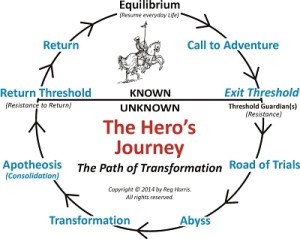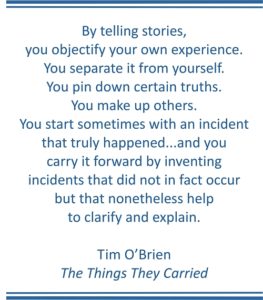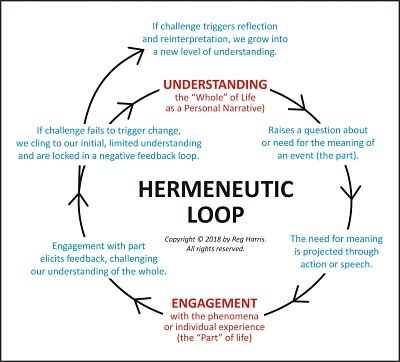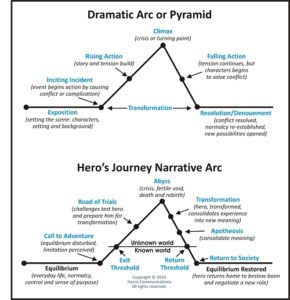NOTE: You are welcome to link to this article, but it is copyrighted. Do not copy or repost it. If you would like a PDF copy to use in your class or work, please contact me.
Seeing our Journeys with “Soft Eyes”
by Reg Harris
The “peripheries” of our lives

When we understand the whole Hero’s Journey pattern, we can see the individual elements and challenges in a larger context. Seeing them in this way, with “soft eyes,” helps us give meaning to what we are experiencing and place it within the context of our lives.
The Hero’s Journey describes both the structure of our personal narrative and the process we go through as we revise that structure. The pattern acts as a map to guide us through our transformative experiences.
In an interview with New Dimensions Radio, psychologist Carol Pearson says we need to navigate our journeys with “soft eyes.” According to Pearson, seeing with soft eyes means maintaining the focus needed to pursue our goals while, at the same time, keeping our vision open for other possibilities that may be available to us. Pearson calls this seeing the “periphery” of our lives where we might find other, unanticipated options or opportunities that could help us reach our goal more quickly or that might present another, more fulfilling purpose.
I would like to suggest that seeing with soft eyes applies to the Hero’s Journey in another context: seeing beyond the limitations and definitions of our personal narratives. Personal narratives are the “self stories” our brains create to organize the events in our lives and give them coherence and meaning. While our narratives provide the template for our interactions with ourselves and our world, they can also limit us by constricting our vision of what’s possible.
In this discussion, I’ll explore the biological foundations of the narrative self and its implications in life, and we’ll look at how to “see with soft eyes” to find those opportunities and potentials that lie on the periphery of our lives.
We Create Our Stories and Our Stories Create Us
We achieve our personal identities and self concept through the use
of the narrative configuration and make our existence into a whole,
understanding it as an expression of a single unfolding and developing story.
~ Donald Polkinghorne (1988) ~
The Interpreter
According to neurobiologist Michael Gazzaniga, the narrative processing of experience is carried out by modules in our left brain hemisphere which he calls the “Interpreter.” The Interpreter is responsible for seeking or creating explanations for why things happen. Gazzaniga writes,
[The Interpreter] engages in the human tendency to find order in chaos, that tries to fit everything into a story and put it into a context… This is what our brain does all day long. It takes input from other areas of our brain and from the environment and synthesizes it into a story (2016).
 But the Interpreter doesn’t select only actual experiences to blend into our narrative. It “weaves together autobiographical fact and newly devised fiction to produce a self-narrative that maintains the sense of a continuous self” (Gallop, 2003). In other words, when “facts” are not available, the Interpreter invents them to fill the gaps and smooth inconsistencies in our story. This also means that our personal narratives are less concerned with facts than they are with meanings, so they should not be judged based on their faithfulness to empirical fact, but on their believability, their coherence and their ability to help us fulfilling, meaningful lives.
But the Interpreter doesn’t select only actual experiences to blend into our narrative. It “weaves together autobiographical fact and newly devised fiction to produce a self-narrative that maintains the sense of a continuous self” (Gallop, 2003). In other words, when “facts” are not available, the Interpreter invents them to fill the gaps and smooth inconsistencies in our story. This also means that our personal narratives are less concerned with facts than they are with meanings, so they should not be judged based on their faithfulness to empirical fact, but on their believability, their coherence and their ability to help us fulfilling, meaningful lives.
We Live out the Plots of Our Own Stories
So our brains have a biological drive to blend fact with fiction to create a coherent whole. This personal narrative, with its foundation in both fact and fiction, creates our sense of identity and defines how we view both our lives and ourselves. More importantly, it gives our lives a sense of purpose or meaning and constitutes a critical element in our self-identity. We create the tone or plot line for our personal narrative early in life. Then our narrative “creates us” as this plot line determines our attitudes toward ourselves and our world. According to Pearson,
Our experience quite literally is defined by our assumptions about life. We make stories about the world and to a large degree live out their plots. What our lives are like depends to a great extent on the script we consciously, or more likely, unconsciously, have adopted (1989, p. xxv).
In other words, if we have developed a narrative in which we are a victim, we will be inclined to view life through a “victim’s lens:” we will see challenges not as steps toward growth and self-realization, but as just more proof that life is out to get us. When we adopt the victim narrative, we surrender our power to act in our own lives: we are at the mercy of outside forces and are unable to change them. This self-victimization creates a negative feedback loop in which, because we have surrendered our power to act, we don’t act, so the situation gets worse, confirming what we believed in the first place: that we are victims. (For more on this concept, see my article on the locus of control, Attributing Outcomes: Journey from Victim to Hero.)
If, on the other hand, we have developed a narrative in which we are the heroes of our own stories, life will be rich and full of opportunities. Challenges—rather than victimizing us—will develop our skills, expand our horizons and strengthen our character. When we believe that the power to direct our lives resides in ourselves, we will feel confident to take action. This creates a positive feedback loop in which each success leads to more success as it reinforces our confidence and opens new possibilities.
In either case, victim or hero, our personal narrative will direct our view of life and guide our actions. Its values, assumptions and biases will color everything we see and do. If we can’t soften our focus and see beyond our narrative, we may become trapped, forever reliving and reinforcing the same old stories, unable to envision alternative or healthier interpretations of the plot of our lives. As Kim Schneiderman writes in Step Out of Your Story, “Perhaps because we have been taught to view life through one particular lens, we simply don’t see other, more inspiring versions of our tale that could liberate us” (2015,p. 14).
The Paradoxical Nature of Change
By experiencing the pattern of the hero’s journey,
many people have found that they know the form of transformation;
then, as change inevitably occurs in their lives, it no longer threatens them.
They know it will have a certain sequence. They have a map.
~ Paul Rebillot (1993) ~
Another way of understanding the importance of soft eyes in our journeys is to think of our personal narrative as our interface with our world. We are constantly growing and changing. At the same time, our world is evolving and changing around us. To maintain a viable, dynamic relationship between ourselves and our world, our personal narrative must constantly change. Unfortunately, because our personal narrative gives us our sense of self, changing it can threaten our grip on who we are.
This creates a difficult paradox, which often takes the shape of the Threshold Guardian in the Hero’s Journey: changing our narrative threatens our sense of self; not changing our narrative threatens the meaning of our life. Ideally, our life is a coherent, united story. All of the details work to explain the story logically, with every element in its proper, causal place. But the reverse is also true. If a coherent narrative is the foundation of health, an incoherent story can be seen as the breeding ground for illness. Dan McAdams writes, “To fail in this effort of mythmaking is to experience the malaise and stagnation that come with an insufficient narration of human life” (1993, p. 166).
So our narrative must remain porous and adaptable if it is to stay healthy. It must resolve the paradox in which we must allow the self to die so that the self can be born. In Your Mythic Journey, Jungian psychologist Sam Keen summarizes this paradox:
While personal myths [narratives] give us a sense of identity, continuity, and security, they become constricting and boring if they are not revised from time to time. To remain vibrant throughout a lifetime we must always be [re]inventing ourselves, weaving new themes into our life-narratives, remembering our past, re-visioning our future, reauthorizing the myth by which we live (1989, p. xiv-xv).
 In the terms of the Hero’s Journey, failing to reinvent ourselves destroys the vibrancy and flexibility of our personal narrative, locking us into the negative feedback loop that is the Call Refused. When we refuse the Call to Adventure, we trap ourselves in a hermeneutic loop in which our current story sustains and entrenches itself. Our brain sifts through potential “narratives” (possible interpretations of an experience) and selects only those that are already coherent with our existing narrative. Then it assigns meanings to the selected experiences that harmonize with its established understandings and biases. As a result, our narrative never changes.
In the terms of the Hero’s Journey, failing to reinvent ourselves destroys the vibrancy and flexibility of our personal narrative, locking us into the negative feedback loop that is the Call Refused. When we refuse the Call to Adventure, we trap ourselves in a hermeneutic loop in which our current story sustains and entrenches itself. Our brain sifts through potential “narratives” (possible interpretations of an experience) and selects only those that are already coherent with our existing narrative. Then it assigns meanings to the selected experiences that harmonize with its established understandings and biases. As a result, our narrative never changes.
To break this loop, we must see with “soft eyes,” and look beyond the potentials and self-definitions imposed on us by our narrative. (See “Climbing Kilimanjaro: Michael Crichton Redefines Himself.”) This self-redefinition is one important purpose of the Hero’s Journey”: to break us free of a negative hermeneutic loop by expanding our vision, allowing us to revise our narrative. Should we fail in this endeavor, we may become locked in a life devoid of meaning and fulfillment. As Pearson writes in The Hero Within,
If we do not risk [the journey]…we feel numb; we experience a sense of alienation, a void, an emptiness inside…In shying away from the quest, we experience nonlife and, accordingly, we call forth less life in the culture (1979, p. 1).
Freeing our Stories: Seeing with Soft Eyes
Simply writing or performing a story about oneself
can prove to be an experience of healing and growth.
~Dan McAdams, The Stories We Live By ~
The question is how can we “soften” our vision so that we can escape this loop and see the peripheries of our lives and the potentials they offer. The most important step to self redefinition is to understand that we cannot change the events that led to our current life narrative, but we can change how we choose remember and interpret those events. “Our lives may be determined less by past events than by the way we remember them,” explains Catherine Ann Jones. “Memory is very subjective and changeable…The way we remember is probably as or more important than what actually happened” (2014).
So the way to “redeem” emotionally negative situations and transform them into productive experiences is to “remember” them differently, that is, to reinterpret them. This requires that we ask ourselves two questions:
1. What story have I created to explain the impact of this experience on my life?
2. What alternative interpretations are available that will turn this negative experience into a growth experience?”
To answer these questions we must first distance ourselves from our stories and the emotions attached to them because while we are “in” our stories, we cannot see and evaluate them. Unless we separate ourselves from them, our stories will continue to dictate what we perceive and feel and how we react to challenges. We must, as Kim Schneiderman says, “step outside our stories,” externalize them to create an emotional distance that will give us a perspective from we can explore, evaluate and “edit” them. Schneiderman uses two tools to help her clients accomplish this task:
1. The narrative structure as a framework for understanding and exploring our stories, and
2. The third-person point of view as the lens through which we gain the perspective to do that exploration.
 Schneiderman’s approach is similar to the approach used by most narrative therapists: externalize the story, revise the the story and reincorporate the new story. She uses the traditional narrative structure (the “Dramatic Arc” or “Freitag’s Pyramid) as the basis for this process, though I would suggest that the Hero’s Journey structure would work as well or, perhaps, better (see diagram right).
Schneiderman’s approach is similar to the approach used by most narrative therapists: externalize the story, revise the the story and reincorporate the new story. She uses the traditional narrative structure (the “Dramatic Arc” or “Freitag’s Pyramid) as the basis for this process, though I would suggest that the Hero’s Journey structure would work as well or, perhaps, better (see diagram right).
To acquire the objective perspective necessary for revision, Schneiderman has her clients write in the third-person point of view, as if they are describing someone else’s story as it develops. The distance afforded by the third-person perspective “enables people to reconstruct an understanding of their experiences and gain new insights without feeling emotionally overwhelmed” (Schneiderman, 2015, p. 26). She has a great deal of research to support her third-person technique.
In her book, Step out of Your Story, she provides a step-by-step approach and dozens of writing exercises to help readers through this process. If you’re interested in her approach, I suggest her short interview with Justine Willis-Toms at the New Dimensions Radio “Café,” “Writing from a Larger Narrative of Your Life” (free download).
Another therapist who uses writing to help her clients adopt a broader perspective on their lives is Catherine Ann Jones, author of Heal Your Self with Writing. Jones nurtures the revisioning process by helping clients use focused journaling to change the way they have “storied” their experiences.
Like Schneiderman, Jones uses writing exercises to help her clients put some distance between their experiences and themselves. This creates a “healing gap” that removes the emotional reaction to memories and allows clients to look at their past more objectively. To use Pearson’s terms, Jones helps her clients “soften their eyes” to gain a perspective beyond the beliefs and biases embedded in their personal narratives. (Again, if you want to know more about Jones and her approach, I recommend her book or her free interview at New Dimensions Radio “Café,” “Knowing Yourself More Deeply through Writing.”)
Discovering the “Larger Story”
“How, then, can we change the pattern and transform the suffering?
Transformation occurs in the discovery of the Larger Story”
~ Jean Houston, In Search of the Beloved ~
As I wrote earlier, to see with “soft eyes” and redeem our narrative, we must acknowledge that we can’t change the experiences we’ve had, but we can change how we remember and interpret them. We can do this by shifting our perspective and revising our interpretations of them. The narrative approaches I discussed above—and narrative therapies in general—follow a basic pattern based on the idea that before we can change our narrative, we must first know our narrative (see my article “Gestalt’s Paradoxical Theory of Change”), and to really know our narrative, we must distance ourselves from it. Here are the steps in the basic pattern:
1. Externalize your current story. To know your story objectively you must distance yourself psychologically from your narrative and its emotional content: you must create a “healing gap” to break your emotional attachment to the experience. You can do this by stepping back and looking at your story as an observer rather than staying engaged in it as a participant.
2. Explore your story. Once you established the healing gap, you can explore your narrative, its elements and the impact they are having on your life. This is made easier because when you use a non-first-person point of view—referring to yourself by name (third person) or as “you” (second person), like a sympathetic friend—you will tend to be more compassionate and supportive of yourself.
3. Consider alternative narratives threads. From this greater perspective, look for alternative or competing interpretations of negative experiences, interpretations that can “redeem” those experiences and turn them into learning opportunities, stepping stones to a more expansive and fulfilling future.
4. Select a narrative thread (or threads). From the various competing interpretations, select a narrative thread (or threads) that are more in concert with who you are and more supportive of the journey you hope to take. Often you may not really know what journey you want, so look for threads that resonate for your, even if you cannot understand or explain them at this time.
5. Reintegrate the new narrative thread into your overall personal narrative. In other words, put the new story into play in your life. When an old, programmed response arises, stop, acknowledge it and replace it with the new narrative. This process may be difficult. It requires mindfulness and, perhaps, some help, but over time, you can reprogram your brain and revise your story.
There are many books that can help you through this process. In addition to the books by Jones and Schneiderman, you might take a look at The Mythic Path (Feinstein and Krippner) and The Path of the Everyday Hero (Catford and Ray). Finally, I would add a sixth step to this process based on Joseph Campbell’s famous words: “Follow your bliss…and doors will open where you didn’t know they were going to be” (1988, p. 120).
6. Watch for synchronicities. Your revised narrative will open new possibilities in your life. These possibilities often just “show up:” new people who share your perspective and goals will appear, opportunities for action will open and your expanded horizon will reveal a new range of possibilities. You are, after all, a different person seeing life through clearer, softer eyes.
Every journey we take in life is a journey of transformation, a revising of our personal narrative. We begin in one place, living one story, and when the journey is done successfully, we arrive at a new place, living the “larger story” that was being born when we heard our Call to Adventure. We can accomplish this transformation only when we step back for an objective look at who we are and at the “plots” that are dictating the story we are living.
This is the task of the Hero’s Journey: to give us perspective, guide us through the transformation and its stages, and to take us to the broader, deeper understanding that puts us more in tune with the person we have become.
References
Campbell, J. (1988). The Power of Myth. (with B. Moyers). New York: Doubleday.
Gallup, G., Anderson, J. and Platek S. Self-narrative in schizophrenia. (2003). The self in neuroscience and psychiatry. (ed. Kircher, T. & A. David). New York: Cambridge University Press. (pp. 147-165)
Gazzaniga, M. (2016). Who’s in Charge Here? London: Constablerobinson.
Houston, J. (1987). In Search of the Beloved: Journeys in mythology and sacred psychology (1st ed.). New York: Jeremy P. Tarcher/Putnam.
Jones, C. (2014). (2/28/2014 ). Knowing Your Self More Deeply through Writing. [Radio Broadcast]. Santa Rosa, CA: New Dimensions Radio. (Link here.)
Jones, C. (2014, February 28). Healing through Focused Journaling. [Radio Broadcast]. Santa Rosa, CA: New Dimensions Radio. (Link here.)
Jones, C. (2013). Healing Your Self with Writing. Studio City, CA: Divine Arts Media.
Keen, S. & Valley-Fox, A. (1989). Your mythic journey: Finding meaning in your life through writing and storytelling. Los Angeles: Jeremey Tharcher.
McAdams, D. (1993). The Stories We Live By. New York: The Guilford Press.
Pearson, C. (1979). The Hero Within: Six archetypes we live by. New York: HarperCollins.
Pearson, C. (1989). Awakening the Heroes Within. New York: HarperCollins.
Pearson, C. (8/3/2016). Changing the Narrative of the Stories We Tell Ourselves. [Radio Broadcast]. Santa Rosa, CA: New Dimensions Radio. (Link here).
Polkinghorne, D. E. (1988). Narrative Knowing and the Human Sciences (1st ed.). Albany, NY: State University of New York.
Rebillot, P. (1993). The call to adventure: Bringing the hero’s journey to daily life (1st ed.). NY: HarperCollins.
Schneiderman, K. (8/3/2015). Writing From a Larger Narrative of Your Life. [Radio broadcast]. Santa Rosa, CA: New Dimensions Radio Cafe. (Link here.)
Schneiderman, K. (2015). Step Out of Your Story: Writing Exercises to Reframe and Transform Your Life. Novato, CA: New World Library.
Copyright © 2018 by Reg Harris. All rights reserved. Reproduction of this article or any part thereof in any form without the expressed written permission of the author is strictly prohibited. Posting this article or any part thereof to the Internet in any form without the expressed written permission of the author is a violation of the Digital Millennium Copyright Act and strictly prohibited. For permission to use, please contact Reg Harris.